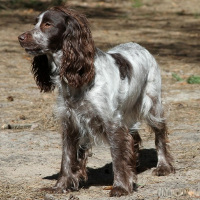Appearance of the Russian Spaniel
|
| The Russian Spaniel is a fairly small breed of Spaniel, usually 30.5 centimeters at the withers, with a straight but slightly elongated back and a strong build. They have round, arched legs with abundant fur between the toes and a thick, straight tail with a fringe that is frequently docked at half their original length. The head is distinctly oval in shape, with a long, broad muzzle, oval eyes in various shades of brown and long, floppy ears that rest close to the eye line and hang close to the cheek; when extended, the ears should only touch the tip of the Russian Spaniel's black or brown nose. This breed's soft coat is moderately long, lies flat against the body and tends to be somewhat reflective in nature. Although they are most often white with darker patches of black, brown and tan, many of these dogs come in black, brown or tan. |
Temperament of the Russian Spaniel
|
| While hunting and scavenging in the field, Russian Spaniels are also devoted and charming animals, with an empathetic and fun-loving attitude when at home. Small children should always be supervised when interacting with a dog, however, this breed tends to be gentle with the youngest group and often makes a jovial playmate. The Russian Spaniel also has a nose for trouble, and although they are generally friendly with everyone, even newcomers, they are known to make very alert and capable watchdogs. They also tend to be open and friendly with most other dogs and cats, although their instinct can lead them to chase birds and rodents, indoors and out. They are highly intelligent and eager to please. Training the Russian Spaniel is generally child's play, but like most Spaniels, they respond best to firm but gentle training methods. |
Needs and activities of the Russian Spaniel
|
| This is a fairly energetic dog, but they are generally satisfied with moderate walking time followed by a vigorous game of fetch. This breed would certainly be happiest with its own garden in which to play, but they are often able to get some exercise playing indoors and are able to adapt easily to an apartment lifestyle. These dogs are highly intelligent and can take part in other activities such as tracking trials, swimming and sports training. Their small size, combined with an outgoing but gentle nature, can make these dogs good candidates for therapy dogs. |
Maintenance of the Russian Spaniel
|
| The medium-length coat naturally repels dirt and water, making it fairly easy to care for. This breed generally has a low dog odor and requires only a few baths a year. Although they do it well, brushing their coat just two or three times a week is enough to prevent tangles, keep the coat from getting out of hand and keep it shiny and healthy. It's also important to ensure that this breed's long ears are kept clean and dry, and are checked frequently to ensure that no water, debris or infection remains in the ear. It's also important to keep an eye on your dog's skin, especially when it's a puppy under five months old, as food allergies in dogs usually result in rashes and skin irritation. Nail and teeth care is a simple task, brushing teeth several times a week and trimming nails as required, usually once a month. |







 English (United Kingdom)
English (United Kingdom)